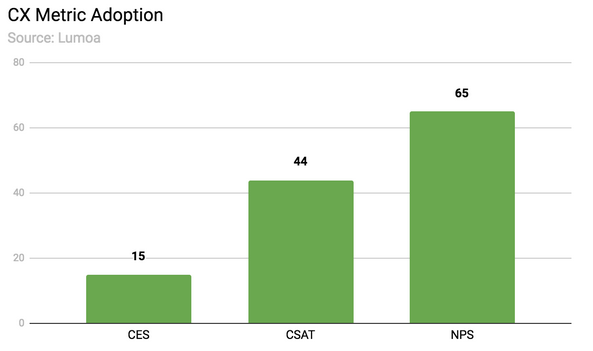Are you measuring key CX metrics yet?
For years, business leaders have known that Customer Experience (CX) is the only sustainable competitive advantage. Just two years ago, Forbes reported that 89% of companies stated they were competing primarily on the basis of customer experience, more than doubling since 2010. And yet their customers disagreed: only 8% of customers recognized the experiences actually being delivered by those companies as superior.
More than halfway through 2020, a pandemic is pressuring businesses and customers in ways that could put even average CX at risk and erode any improvements made to that already massive perception gap. The companies who emerge the strongest from this year will be those making decisions informed by customer data, including perception data that brings a layer of emotion into the mix of the more commonly tracked operational and financial metrics.
If you’re reading this, you’re either already tuning in to your customers’ experience, or you’re about to. If you’re in the ‘getting started’ category, these 3 common CX metrics play well together and should be the first you deploy in your Customer Experience Metrics Program:
- CES – Customer Effort Score – a relatively new metric typically used for interactions such as customer support, where customer ‘ease’ is critical to a positive experience
- CSAT – Customer Satisfaction – typically used at the product or interaction level, provides key insights into weaknesses that should direct improvement actions
- NPS – Net Promoter Score – known as (but not actually) ‘the only metric you need,’ used to measure the overall relationship/loyalty as represented by likelihood to recommend

Building your listening system:
As you build out your customer listening ecosystem, implement it in steps, so your company isn’t overwhelmed by a sudden influx of new metrics. Also, be sure to align it with the customer lifecycle, so your customers aren’t overwhelmed by requests for feedback that are out of sync with their actual experiences. This means:
- Ask about one-time experiences such as Onboarding soon after the actual experience, so you get the most timely feedback and can act quickly to address any shortcomings.
- Trigger Customer Support or Help Desk feedback based on actual interactions, and if there is a high frequency of interactions, don’t ask for feedback every time – your customers will get tired of being asked and you risk annoying them.
- Gather a quick succession of Product feedback early – perhaps at 30, 60 and 90 day intervals. This will tell you if the customer is actually using the product, and again allow for quick intervention if necessary. After that, ask for feedback when new features are activated, or new products or services are enabled.
- Launch your relationship measure close to the 1-year mark, far enough ahead of any contract renewal dates so that you can remediate any concerns and use the input to prepare renewal and upsell proposals.
Getting started with a CX Metrics Program

Socializing and taking action on the results:
It’s not enough just to collect the feedback – you need to make sure the right people have access to the metrics, so that improvements can be made and successes celebrated. There are many ways to ensure broad and deep communication and awareness of the results, but a great way to start is with a simple dashboard, ideally visible to all employees. From there, targeted dashboards or reports can be produced to get a more granular and segmented view of the metrics in front of the right leaders and teams. Don’t assume everyone will understand them – spend some time educating teams on what the metrics mean, how they are gathered, and, most importantly, how to use them to drive action and create better customer experiences that will lower churn, increase upsells, and generate fewer calls for support.
What you need to know about each metric:
Customer Effort Score (CES)
Application: Transactional measure of effort
Audience: Executive team, Customer Service/Support leaders and teams
Strengths: Addresses the concept of ‘ease’ which is increasingly critical to customer retention; a better indicator of customer loyalty and business growth than CSAT
Weaknesses: Not yet widely adopted so fewer benchmarks exist; not relevant to all aspects of customer experience, especially people metrics
Customer Satisfaction (CSAT)
Application: Transactional measure of various product or service attributes
Audience: Product managers and teams, Functional leaders and teams
Strengths: Can be applied to any experience, product, or interaction, including people or teams; scale is easily adaptable, including for ‘image-based’ ratings (ie, smiley faces)
Weaknesses: Satisfaction is an underwhelming bar – satisfied customers switch companies or products all the time; does not necessarily translate to repeat purchases, advocacy, or other behavioral elements of loyalty
Net Promoter Score (NPS)
Application: Relationship measure
Audience: Executive team, Investors, PR, All employees
Strengths: Recognized at the executive level as an indicator of customer loyalty; widely benchmarked
Weaknesses: Oversimplifies customer experience: one metric can’t diagnose root causes or support prioritized improvement; in B2B especially, does not translate to actual recommendations / referrals
One last word of advice: If your company isn’t ready to act on a metric, don’t ask for it. You’ll do more harm than good, and you can always add metrics as your company matures.
Republished with author’s permission from original post.




I love this article by Jennifer Batley because it’s pragmatic and grounded in proven experience. Sets companies up to succeed with a solid CX Measurement Foundation.
You can also dig deeper with robust definitions for the 3 key metrics highlighted here in MetricHQ: https://www.klipfolio.com/metrics/